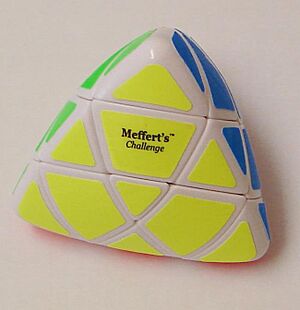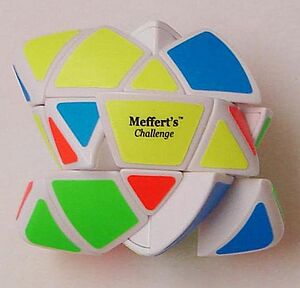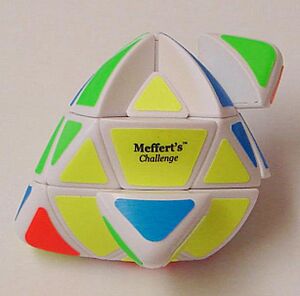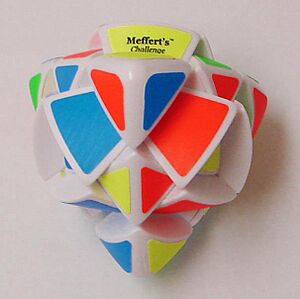Pyramorphix facts for kids
The Pyramorphix is a fun puzzle shaped like a tetrahedron (a pyramid with four triangle faces). It's a lot like the Rubik's Cube, but it has fewer moving parts. While a Rubik's Cube has 20 pieces you can move, the Pyramorphix only has 8.
Even though it looks like a simpler version of the Pyraminx puzzle, the Pyramorphix works differently. It's an "edge-turning" puzzle, which means its inner edges twist. This makes it work just like a Pocket Cube (a 2x2x2 Rubik's Cube).
Contents
What is the Pyramorphix?
At first glance, the Pyramorphix might seem like a simple puzzle. It looks a lot like the Pyraminx, and you might think only its four corners can turn. But it's actually a 2x2x2 cube that has been shaped differently.
Imagine a regular 2x2x2 cube. Four of its corners are shaped into pyramids. The other four corners are shaped into triangles. This special design makes the puzzle change its shape as you twist it. It's not just about mixing colors; the whole shape can become jumbled!
The puzzle was first called "The Junior Pyraminx." But this name was changed to "Pyramorphix." The new name highlights how the puzzle "morphs" or changes shape. It also makes it sound more appealing to older kids and adults. The goal of the puzzle is to scramble both its colors and its shape. Then, you try to return it to its original pyramid shape, with each face showing just one color.
How many ways can you scramble a Pyramorphix?
The Pyramorphix puzzles come with either stickers or plastic tiles on their faces. These pieces often have a ribbed texture. This texture helps you see which way each flat piece is turned.
Because of this, there are 3,674,160 different ways to scramble a Pyramorphix. This is the same number of combinations as a 2x2x2 cube. If the pieces didn't have this texture, it would be harder to tell their orientation. This would reduce the total number of possible combinations.
You can turn the Pyramorphix around three different axes. Each turn is usually a multiple of 90 degrees. Unlike the Pyraminx, the corners of the Pyramorphix cannot spin by themselves. When you twist the Pyramorphix, the pieces move in a way that changes the puzzle's shape. This creates many interesting and unusual forms.
What is the Master Pyramorphix?
The Master Pyramorphix is a more challenging version of the Pyramorphix. People sometimes call it the Mastermorphix. Like the original, it's an edge-turning puzzle shaped like a pyramid. It can change its shape a lot when you twist it. This leads to many irregular and surprising forms.
Different versions of the Master Pyramorphix exist. Some are custom-made by puzzle fans. Others, like the "pillowed" version shown in the pictures, are sold by puzzle maker Uwe Mèffert.
This puzzle has 4 corner pieces, 4 center pieces on the faces, 6 edge pieces, and 12 other face pieces. Since it's an edge-turning puzzle, the edge pieces stay in place but can rotate. The other pieces can swap positions. The face centers and corner pieces can actually trade places because they are both types of "corners" in the puzzle's design, even if they look different. The non-center face pieces can also flip. This is what causes the puzzle to make so many wild shapes when you twist it.
If you only make 180-degree turns, you can scramble just the colors. The puzzle will still keep its pyramid shape. But if you make 90-degree turns, the puzzle will "shape shift" and become very jumbled.
Even though it looks a bit like the Pyraminx, the Master Pyramorphix is very different. The Pyraminx is a "face-turning" puzzle. On the Master Pyramorphix, the corner pieces are important. You can't just spin them in place to fix their orientation.
How to solve the Master Pyramorphix
Despite its complex look, the Master Pyramorphix is actually like a Rubik's Cube that has been reshaped. Its 4 corner pieces and 4 face center pieces together act like the 8 corner pieces of a Rubik's Cube. The 6 edge pieces are like the face centers of a Rubik's Cube. And the non-center face pieces are like the edge pieces of a Rubik's Cube.
This means you can use the same methods to solve the Master Pyramorphix as you would use for a 3x3x3 Rubik's Cube. There are only a few small differences. For example, the center pieces have two colors, so their orientation matters. But the face centers don't really care about their orientation.
Unlike some other shape-changing puzzles, you don't usually fix the Master Pyramorphix's shape first and then solve the colors. Many of the algorithms (special sequences of moves) from the Rubik's Cube will change the shape of the Master Pyramorphix as you solve it. Some solving methods show the shape gradually returning to normal. First, the non-center face pieces are put in place, which starts to restore the pyramid shape. Then, the face centers and corners are solved, bringing the puzzle back to its perfect tetrahedral form.
How many ways can you scramble a Master Pyramorphix?
The Master Pyramorphix has four corners and four face centers. These can be arranged in many different ways. The texture of the stickers on the puzzle makes it possible to see the orientation of the face centers.
The total number of ways to scramble a Master Pyramorphix is very large: 88580102706155225088000. That's over 88 quintillion!
If the stickers were smooth and didn't show orientation, the number of combinations would be smaller. It would be around 5062877383753728000, which is still over 5 quintillion.
See also
 In Spanish: Pyramorphix para niños
In Spanish: Pyramorphix para niños








